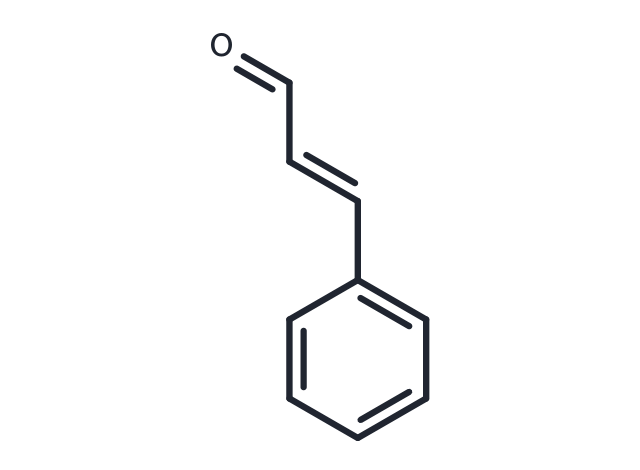Powder: -20°C for 3 years | In solvent: -80°C for 1 year


1. trans-Cinnamaldehyde (Phenylacrolein) exhibits excellent anti-inflammatory activities and antidepressant-like effects in stressed mid-aged rats as a COX-2 inhibitor. 2. Cinnamic aldehyde induces apoptosis of CML cells in vitro, down-regulation of the expression and function of BCR-ABL may be one of its most important anti-leukemia mechanisms. 3. Cinnamic aldehyde and cinnamic acid are cardioprotective in a rat model of ischemic myocardial injury, the mechanism is related to anti-oxidative and anti-inflammatory properties.

| Pack Size | Availability | Price/USD | Quantity |
|---|---|---|---|
| 5 g | In stock | $ 39.00 | |
| 10 g | In stock | $ 55.00 | |
| 1 mL * 10 mM (in DMSO) | In stock | $ 29.00 |


| Description | 1. trans-Cinnamaldehyde (Phenylacrolein) exhibits excellent anti-inflammatory activities and antidepressant-like effects in stressed mid-aged rats as a COX-2 inhibitor. 2. Cinnamic aldehyde induces apoptosis of CML cells in vitro, down-regulation of the expression and function of BCR-ABL may be one of its most important anti-leukemia mechanisms. 3. Cinnamic aldehyde and cinnamic acid are cardioprotective in a rat model of ischemic myocardial injury, the mechanism is related to anti-oxidative and anti-inflammatory properties. |
| Source |
| Synonyms | Cinnamaldehyde, Cinnamic aldehyde, Cinnamal, Phenylacrolein |
| Molecular Weight | 132.16 |
| Formula | C9H8O |
| CAS No. | 14371-10-9 |
Powder: -20°C for 3 years | In solvent: -80°C for 1 year
DMSO: 25 mg/mL (189.16 mM)
You can also refer to dose conversion for different animals. More
bottom
Please see Inhibitor Handling Instructions for more frequently ask questions. Topics include: how to prepare stock solutions, how to store products, and cautions on cell-based assays & animal experiments, etc.
trans-Cinnamaldehyde 14371-10-9 Immunology/Inflammation Metabolism Neuroscience COX Endogenous Metabolite ring Cinnamaldehyde trans Cinnamaldehyde Cinnamic aldehyde inhibit Inhibitor transCinnamaldehyde furan Cinnamal Phenylacrolein inhibitor
